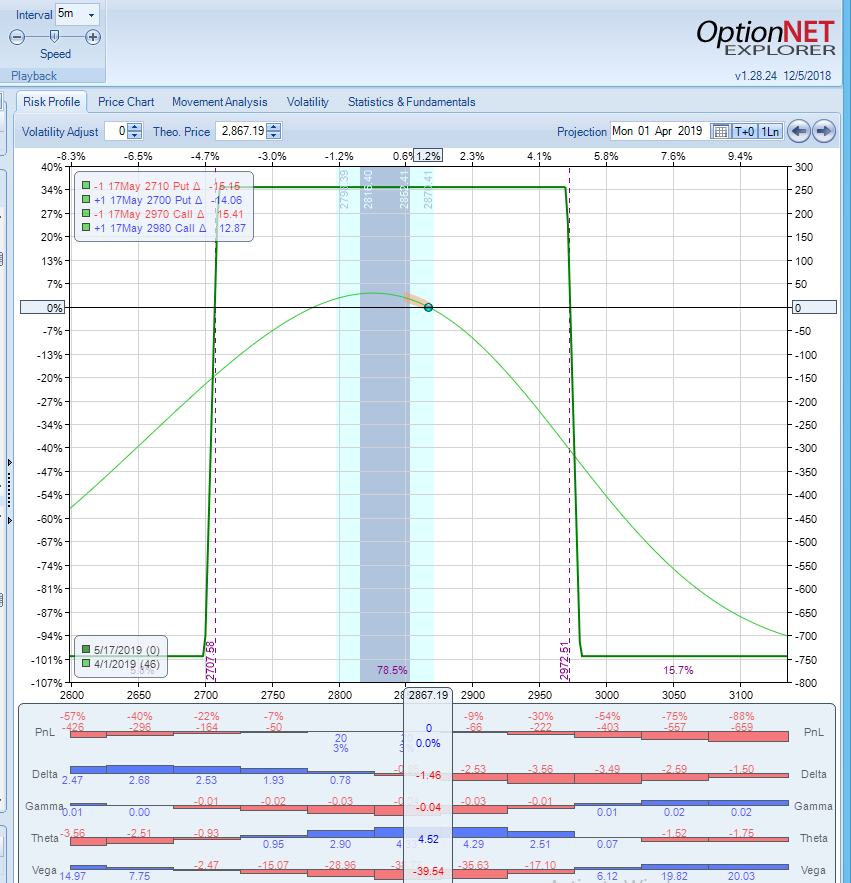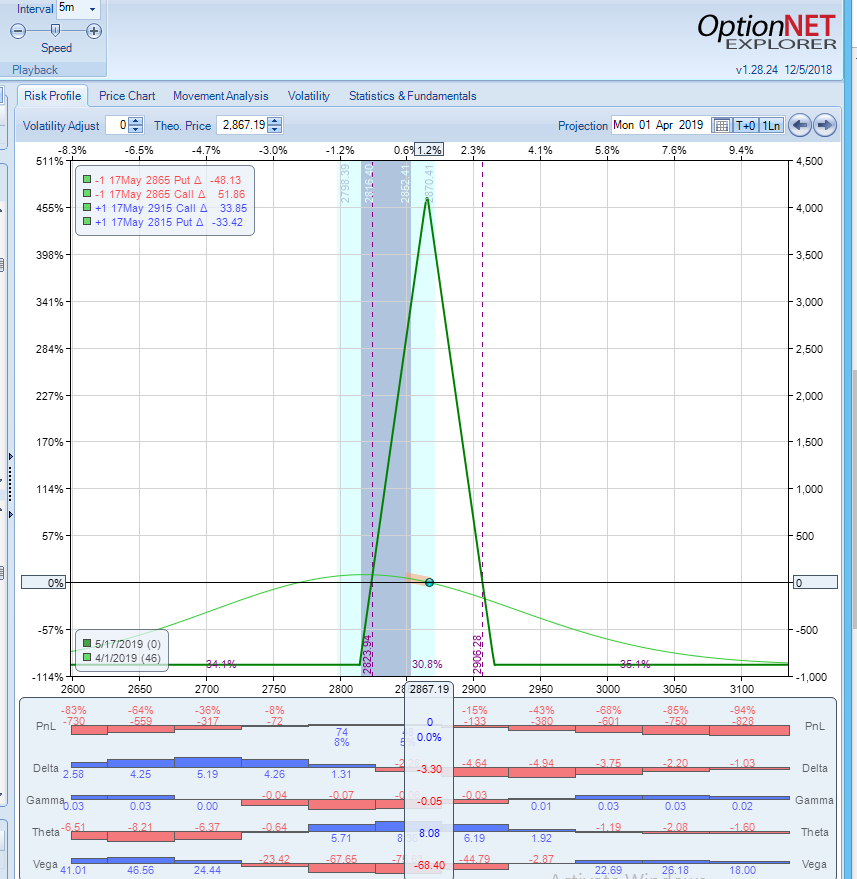
Iron Condor and Iron Butterfly are both very popular strategies. Both of them are usually used as non-directional strategies (although butterflied can be used as a directional trade as well). Both trades are vega negative and gamma negative, but there are also few important differences between those two strategies.
Iron Condor Description
Iron Condor is a vega negative gamma negative trade. Choosing the strike prices for your iron condor position – and deciding how much cash credit you are willing to accept for taking on the risk involved – are irrevocably linked. If your strike has lower deltas, you will get less credit, but also higher probability. As we know, Risk/reward and Probability of Success have reverse relationship.
Buy one out-of-the-money put with a strike price below the current price.
Sell one out-of-the-money put with a strike price closer to the current price.
Sell one out-of-the-money call having a strike price above the current price.
Buy one out-of-the-money call with a strike price further above the current price.
Lets take a look at typical Iron Condor trade using SPX and 15 deltas for the short options.

As we can see, we are risking
$250 (around 33% gain), but we have a fairly high probability of success (
78%). We can select tighter strikes, for higher credit and better risk/reward, but we will be sacrificing the probability of success.
Iron Butterfly Description
Iron Butterfly spread is basically a subset of an Iron Condor strategy using the same strike for the short options.
Buy one out-of-the-money put with a strike price below the current price.
Sell one at-the-money put.
Sell one at-the-money call.
Buy one out-of-the-money call with a strike price above the current price.
Lets take a look at Iron Butterfly trade using SPX:

As we can see, we are risking
$4,120 (around 455% gain), but we have a fairly low probability of success (
30%). We can select further OTM long strikes, for lower credit and higher probability of success. But generally speaking, Iron Butterfly will usually have a better risk/reward but lower probability of success than Iron Butterfly.
Which one is better?
As you can see, there are tradeoffs to each strategy. Both strategies benefit from range bound markets and decrease in Implied Volatility. The Iron Butterfly has more narrow structure than the Iron Condor, and has a better risk-to-reward, but also lower probability of success. If the underlying stays close to the sold strike, the iron Butterfly trade will produce much higher returns.
Both strategies require that the underlying price stay inside of a range for the trade to be profitable. The Iron Condor gives you more room, but the profit potential is usually much less.
Generally speaking, Iron Condor is a High(er) Probability trade and Iron Butterfly is a Low(er) Probability trade. However, those probabilities refer to holding both trades till expiration. In reality, we rarely hold them till expiration. We usually set realistic profit targets and exit at least 2-3 weeks before expiration, to reduce the negative gamma risk.
The bottom line is that the strategies are pretty similar because they profit from the same conditions. The major difference is the maximum profit zone, for a condor is much wider than that for a butterfly, although the tradeoff is a lower profit potential.
What Is SteadyOptions?
Full Trading Plan
Complete Portfolio Approach
Diversified Options Strategies
Exclusive Community Forum
Steady And Consistent Gains
High Quality Education
Risk Management, Portfolio Size
Performance based on real fills
Non-directional Options Strategies
10-15 trade Ideas Per Month
Targets 5-7% Monthly Net Return
Recent Articles
Articles
Pricing Models and Volatility Problems
Most traders are aware of the volatility-related problem with the best-known option pricing model, Black-Scholes. The assumption under this model is that volatility remains constant over the entire remaining life of the option.
By Michael C. Thomsett, August 16

- Added byMichael C. Thomsett
- August 16
Option Arbitrage Risks
Options traders dealing in arbitrage might not appreciate the forms of risk they face. The typical arbitrage position is found in synthetic long or short stock. In these positions, the combined options act exactly like the underlying. This creates the arbitrage.
By Michael C. Thomsett, August 7

- Added byMichael C. Thomsett
- August 7
Why Haven't You Started Investing Yet?
You are probably aware that investment opportunities are great for building wealth. Whether you opt for stocks and shares, precious metals, forex trading, or something else besides, you could afford yourself financial freedom. But if you haven't dipped your toes into the world of investing yet, we have to ask ourselves why.
By Kim, August 7

- Added byKim
- August 7
Historical Drawdowns for Global Equity Portfolios
Globally diversified equity portfolios typically hold thousands of stocks across dozens of countries. This degree of diversification minimizes the risk of a single company, country, or sector. Because of this diversification, investors should be cautious about confusing temporary declines with permanent loss of capital like with single stocks.
By Jesse, August 6

- Added byJesse
- August 6
Types of Volatility
Are most options traders aware of five different types of volatility? Probably not. Most only deal with two types, historical and implied. All five types (historical, implied, future, forecast and seasonal), deserve some explanation and study.
By Michael C. Thomsett, August 1

- Added byMichael C. Thomsett
- August 1
The Performance Gap Between Large Growth and Small Value Stocks
Academic research suggests there are differences in expected returns among stocks over the long-term. Small companies with low fundamental valuations (Small Cap Value) have higher expected returns than big companies with high valuations (Large Cap Growth).
By Jesse, July 21

- Added byJesse
- July 21
How New Traders Can Use Trade Psychology To Succeed
People have been trying to figure out just what makes humans tick for hundreds of years. In some respects, we’ve come a long way, in others, we’ve barely scratched the surface. Like it or not, many industries take advantage of this knowledge to influence our behaviour and buying patterns.

- Added byKim
- July 21
A Reliable Reversal Signal
Options traders struggle constantly with the quest for reliable
By Michael C. Thomsett, July 20

- Added byMichael C. Thomsett
- July 20
Premium at Risk
Should options traders consider “premium at risk” when entering strategies? Most traders focus on calculated maximum profit or loss and breakeven price levels. But inefficiencies in option behavior, especially when close to expiration, make these basic calculations limited in value, and at times misleading.
By Michael C. Thomsett, July 13

- Added byMichael C. Thomsett
- July 13
Diversified Leveraged Anchor Performance
In our continued efforts to improve the Anchor strategy, in April of this year we began tracking a Diversified Leveraged Anchor strategy, under the theory that, over time, a diversified portfolio performs better than an undiversified portfolio in numerous metrics. Not only does overall performance tend to increase, but volatility and drawdowns tend to decrease: